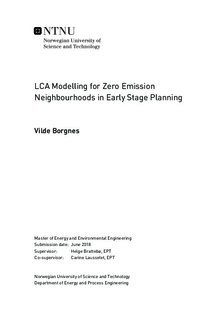LCA Modelling for Zero Emission Neighbourhoods in Early Stage Planning
Master thesis
Permanent lenke
http://hdl.handle.net/11250/2562285Utgivelsesdato
2018Metadata
Vis full innførselSamlinger
Sammendrag
The building sector is a major driver of climate change and recent years it has been a growing focus on limiting greenhouse gas (GHG) emissions associated with the built environment. In Norway, the Research Centre on Zero Emissions Neighborhoods (ZEN Centre) has a goal of developing future buildings and neighborhoods with no GHG emissions. To estimate the total emissions caused by buildings throughout the entire life cycle, life cycle assessment (LCA) is a commonly used and well-established tool. When studying more complex systems as neighborhoods however, the existing research is scarce.
The objective of the work in hand is to contribute to expedient use of LCA of neighborhoods at an early planning stage, by focusing on contributors to environmental impacts and critical factors. An LCA model for ZENs based on a modular structure was developed with five included elements; buildings, mobility, open spaces, networks and on-site energy infrastructure. The model was tested on Zero Village Bergen, a pilot project for the ZEN Centre. The results gave a total of 117 kg tonne CO2-eq over 60 years. The buildings constituted the largest share of emissions among the elements with 52%, and the emission embodied in the materials accounted for 56% when all elements were included. Critical parameters are emission intensities for electricity and heat production by waste incineration, as well as the daily distance travelled by the inhabitants.
The model has clear potential to facilitate decision making in early stage planning of ZENs, as it provides information on dominant elements and life cycle stages, and its modular structure ensures comparability and adaptability. On the other hand, the LCA model, and consequently also the results, suffer from uncertainties and simplifications, particularly on how technology and behaviour may change in a long-term perspective. Further work is therefore suggested.
